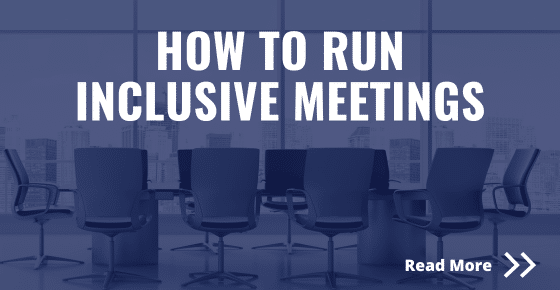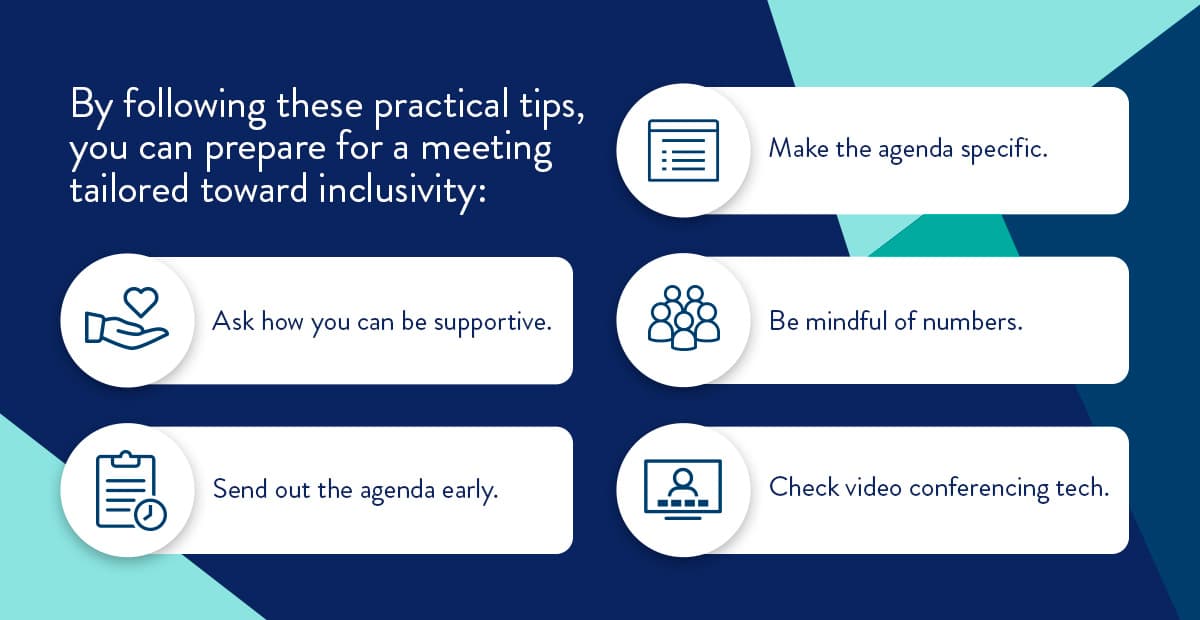Inclusive Culture Alignment, Leadership
How to Run Inclusive Meetings

When executed effectively, meetings can be one of your company’s most valuable resources. Inclusive meetings allow you to create a space where your team members feel valued and represented. They can also benefit your company by contributing to better problem-solving, decision-making and stronger values.
Running inclusive meetings involves preparation, moderating meetings for optimal engagement and collecting feedback that helps you continue to grow.
What Is an Inclusive Meeting?
An inclusive meeting provides a fair and level playing field so that each person on your team has the opportunity and confidence to participate and contribute. In inclusive meetings, team members are less likely to feel marginalized, dominated or as if other coworkers are favored over them.
Inclusion is vital for your team and company’s success. By diversifying your meetings and creating an environment where everyone feels valued, you grow your company’s values and outcomes.
The Benefits of Running Inclusive Meetings
Inclusive meetings are well worth the planning that goes into them. They can provide the following benefits:
- You open up more channels for communication and collaboration.
- Problem-solving becomes more creative and innovative, as you have various perspectives and ideas to lean on.
- The company’s decisions impact teams and end users. Having diverse and inclusive teams whose voices are heard ensures that decision-making benefits more staff.
- You can improve team morale, as team members will feel more appreciated knowing that their contributions matter.
- By prioritizing inclusivity, you can help staff feel more engaged and receive value from the meetings. Gone are the days of monotone meetings with disengaged team members!
- You can strengthen company culture by prioritizing inclusive meetings. Your company’s values will be more representative of your staff, and this will reflect in your decision-making, too.
How to Make Meetings More Inclusive
You can implement a few steps to set your meetings up for success. Here are some strategies you can use to make meetings more inclusive.
Plan and Prepare

As with any other work task, preparation is key. By following these practical tips, you can prepare for a meeting tailored toward inclusivity:
- Ask how you can be supportive: Before setting the agenda, send out an invitation and ask people to respond with what they want or need from the meeting, as well as how you can support them. Asking these questions beforehand allows you to prepare or adjust as needed to support any staff members with specific requests.
- Send out the agenda early: Oftentimes, individuals do not participate in meetings because they feel unprepared and unsure of themselves. By sending out the agenda early, you allow team members to reflect on talking points and form their opinions and suggestions beforehand.
- Make the agenda specific: Another way to help team members prepare is by making the agenda as specific as possible. Instead of listing generic topics that leave team members guessing, you can list specific topics and detail what you want to achieve for each talking point.
- Be mindful of numbers: The aim of inclusive meetings is for everyone to participate. This becomes much harder to achieve if there are too many people in the meeting. To help with this, consider the agenda and goal of the meeting. If it’s to discuss objectives for junior-level marketing staff, only invite that team or those the outcomes will impact.
- Check video conferencing tech: Hosting virtual meetings can promote diversity and inclusion, as people can participate from various locations. If you choose to go this route, check all your video conferencing tech beforehand. Confirm it will work during the meeting so members can speak and listen to each other, fully participate and absorb the information.
Lay Meaningful Ground Rules
Laying some foundations for your inclusive meeting helps ensure everyone’s voice is heard. Rules can include turning off cellphones during meetings, sticking to the agenda and not speaking over others. The rules may seem simple, but they set the tone for a truly inclusive meeting that allows everyone to participate.
Moderate the Meeting
Effectively moderating the meeting ensures that everyone gets a turn to voice their opinions and that no one dominates the conversation. You can try practicing the following tips when moderating:
- Set the tone with a welcome: Start with a warm welcome. Make it clear that there are no silly ideas or opinions, and everyone’s contribution is valued regardless of the meeting outcome.
- Give everyone an opportunity: During the meeting, you can directly prompt those you notice aren’t participating as much. This can be as simple as looking at a person, addressing them by name and gently asking for their opinion. Just remember that moderating should never force participation — only encourage it.
- Gently interject if someone is dominating: Some members may feel that the only way to voice their opinions is to interrupt others. However, allowing an environment where members interrupt and talk over others can make meetings less inclusive. When you notice interruptions, gently address the person and say you would love to hear their side, but after the other member has shared theirs.
- Be aware of confirmation bias and favoritism: As a moderator, it is vital to recognize and eliminate confirmation bias and favoritism. By only praising opinions you already agree with or allowing team members who dominate the dialogue to speak, you automatically exclude other team members.
Be Mindful of Cultural Differences
Inclusivity and diversity go hand in hand. Your meetings will often include team members of different genders, ethnicities, nationalities, religions and ages. Recognizing diverse backgrounds and practicing cultural sensitivity during your meetings is crucial for inclusivity.
As a leader, the easiest way to practice cultural sensitivity in the workplace is by being willing to learn new things and adapt. There are many different customs for things like shaking hands, maintaining eye contact, addressing someone formally and more. Preparing beforehand shows your respect and honors team members, but if there is a small blunder, simply be gracious in apologizing, learning and moving on.
Have Follow-Ups for Continued Improvement
Working toward inclusivity does not end when the meeting concludes — it should be a continuous effort that is integral to your company’s values. Inviting team members to share their feedback after meetings is an excellent way to discover how you can continue to grow. You can try various feedback mechanisms, such as making surveys anonymous so that team members feel confident in sharing ideas for improvement.
Develop Meaningful Workplace Inclusivity With Exude Human Capital
Exploring how you can run more inclusive meetings is a powerful step toward creating a work environment that is diverse, fair and appreciative of all team members. At Exude Human Capital, we provide HR solutions that develop and improve your Diversity, Equity, Inclusion and Belonging (DEIB) programs.
Our DEIB solutions include Inclusive Culture Alignment Tools, DEIB Consulting, DEIB Data Collection, DEIB Facilitated Conversations and DEIB Training. With our professional team and resources, you can grow your company’s DEIB programs meaningfully. Contact us for a complimentary 30-minute consultation to learn more!








